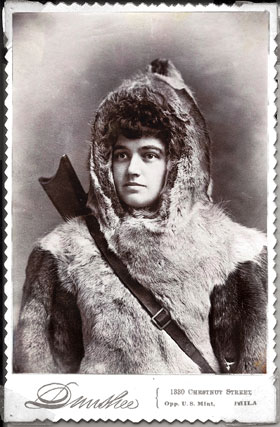2009
Josephine Peary was hardly amused when her husband, polar explorer Robert Peary, confessed he’d fallen in with an Inuit woman at the dome of the world. Undaunted, she courageously kept her marriage together and became a best-selling author, retiring to 290 Baxter Boulevard.
 As a young woman in the 1880s, Josephine Diebitsch socialized among the literati in the nation’s capital, wearing white gloves or carrying a parasol. Before long, in the company of Robert Edwin Peary, one of Maine’s most famous Arctic explorers, she found herself hunting reindeer hundreds of miles north of the Arctic Circle, sporting sealskin gloves and a Winchester rifle.
As a young woman in the 1880s, Josephine Diebitsch socialized among the literati in the nation’s capital, wearing white gloves or carrying a parasol. Before long, in the company of Robert Edwin Peary, one of Maine’s most famous Arctic explorers, she found herself hunting reindeer hundreds of miles north of the Arctic Circle, sporting sealskin gloves and a Winchester rifle.
Josephine fell in love with the young Navy lieutenant Peary, a Bowdoin-educated civil engineer who indulged his penchant for supporting America’s nineteenth-century expansionism. As he hacked his way through the jungles of Nicaragua, surveying for a shipping canal (later shifted to Panama), Josephine wrote of her devotion to him. In one she pledged: “I will be just as happy with you in Nicaragua as I would be in Greenland and just as happy in either of these places as I would be in New York.”
Peary held her to this promise. As a young man, he’d become infected, metaphorically speaking, with “Arctic fever,” a passion for discovering the mysteries at the top of the world. Three years after their 1888 marriage, Josephine sailed with “Bert” on the barkentine Kite, a 280-ton sealer outfitted for the geographic exploration of Greenland.
Like sea captains’ wives before her, Josephine maintained the role and dress code befitting a lady of her time while on board ship. Ashore, however, barren terrain and temperatures reaching 50 or more degrees below zero required radical modifications to women’s fashion typical for her time.
On one hike in the chilly Arctic summer, Josephine wore a “red blanket combination suit” with a scandalously short, that is, ankle-revealing, hemline. She concluded, “When you go out in a city, you think more particularly about how you look. In the North, you dress to be warm and nothing else.”
Josephine’s participation on the expedition, as much as her exposed ankles, raised a few eyebrows. The Arctic had long been the region where men “ate their boots,” if not each other. John Verhoeff, a member of the Greenland expedition, quipped, “The Arctic is certainly no place for ‘the Woman.’” Unabashed, Josephine confided to her diary: “[Verhoeff] is an uncanny and very homely dwarf. Nothing gentlemanly about him. There is no doubt that he is not quite right in the ‘upper story.’”
Another expedition member’s presence surprised “gentlemen scientists,” that of Matthew Henson, an African-American whom Peary had cast as “valet” or “manservant,” something he ap parently required in Nicaraguan jungle and frozen desert alike.
Once settled on the northwestern coast of Greenland, Peary enlarged the support team, recruiting Inuit families to work as hunters, guides, and seamstresses. Peary traded guns, needles, knives, and biscuits for sled dogs, meat for dog food, and fur clothing, Inuit-tailored for Arctic survival. Although Josephine adopted the fur parka and mitts, she drew the line at traditional Inuit undergarments–including birdskin shirts–opting for long woolies instead. Later, she downplayed the challenges for reporters, “I was never cold. That was one reason why I felt able to go. I have suffered more here [in D.C.] from cold than I did in the North.”
More difficult was basic housekeeping for the expedition. Josephine marvelled, “It was no easy task for me to cook for six boys, and for such appetites.” Josephine quickly learned that Henson’s cooking skills were as competent as his carpentry and acquisition of Inuit language. By November, she celebrated, “Matt got supper tonight, and will from now until May 1 prepare all the meals under my supervision. This gives me more time to myself.” By May, Josephine relied most upon him as a fellow explorer: “I have determined to go to the head of the bay…to await Mr. Peary’s return, and I wish to have Matt for my companion.” Henson’s trustworthiness and skills would become increasingly indispensable, if still underacknowledged, with each subsequent expedition.
After the expedition’s return in 1892, reporters, eager to publish tidbits about “housekeeping in the North,” sought Josephine out nearly as much as her husband. This acclaim helped launch her writing career with publication of her first of three books, My Arctic Journal: A Year Among Ice-Fields and Eskimos. While her husband published alternatively terse and epic prose in his accounts, Josephine revealed the buffoonery that characterized Arctic expeditions.
For instance, during a hunting trip, the party ran out of rifle ammunition and resorted to wrestling a wounded reindeer to the ground until they could shoot it point blank with a revolver. Later, Frederick Cook, the German-American doctor and future Peary archenemy, carried Josephine across a glacial stream. He crossed back for Norwegian outdoorsman Eivind Astrup. Josephine observed: “Ikwa, who had taken off his kamiks and stockings and waded the stream, was lying flat on his back on a mossy bank nearly convulsed with laughter at the sight of the doctor carrying Astrup.”
Embarking on the second expedition, Josephine attracted even greater attention, since she was eight months pregnant. On September 12th, 1893, Josephine gave birth to a baby girl, Marie, later the subject of her world-famous nonfiction bestseller, The Snow Baby. Cynics from many quarters challenged the Pearys’ judgment in good parenting by risking their newborn to the piercing cold. Even the expedition’s physician speculated about whether or not the child, like a plant, could survive the winter without sunlight. Josephine faced more immediate concerns: “Every thing available put on my bed to catch the water which comes down in streams…House leaks very much.” Undaunted, she swaddled Marie–later nicknamed the Snow Baby–in the expedition’s American flag. As the weather cleared, she photographed little Marie outside in the last twilight they would see for months.
As an Arctic celebrity, Josephine’s personal life was painfully public. Newspapers lauded her loyalty in enduring Peary’s lengthy absences as he slogged, year after year, toward the elusive North Pole. Upon her second pregnancy, in 1898, Josephine remained behind in D.C., sending Robert off with a 45-star American flag that she’d sewn of taffeta. Peary later reported he wore this memento “wrapped about [my] body” to safeguard it in case his sledge broke through the ice.
While the flag-wrapped Peary continued to fall short of the Pole, Josephine gave birth to their second child, Francis, in January of 1899, only to lose her to illness eight months later. “I shall never feel quite the same again; part of me is in the little grave,” she confessed. Soon after the loss, news arrived by ship that Peary had lost eight of his toes to frostbite and had gained an Inuit mistress.
Rather than boot him the rest of the way to the Pole, Josephine turned the blame inward: “I used to brag, sweetheart, that I did not feel married, but I feel very much so now and look it, too. You will wish yourself back with your sleek, fat Eskimo woman after you have seen me. If you have succeeded, everything will look rosy to you for a little while and you may even persuade yourself that I am not half bad.” She penned this not once, but five times–sending multiple copies northward via whaling ships. Despite Peary’s infidelity, he and Josephine continued their romance, privately and in the headlines.
In 1909, twenty-one years after Josephine married Robert Peary, he sent her a telegram at their summer home on Eagle Island announcing that five months earlier he’d planted her Stars and Stripes at the North Pole. For years, Peary had been cutting out pieces of Josephine’s flag, leaving them at his “farthest north” conquests. At the Pole, he left behind a diagonal slice.
Robert’s discovery, and the controversy generated by Cook’s competing claim, catapulted the Peary family even further into the limelight. Four years later, in 1913, Robert’s gift to Josephine on her 50th birthday attested to the extravagance of their life–a custom-designed necklace of Maine gem tourmalines. Some think the gift was an act of contrition; more likely it was designed to impress guests at the extraordinary events scheduled for that year–medal-granting ceremonies at geographical societies in Geneva and Paris, Marie’s debutante party in D.C., the wedding of Woodrow Wilson’s daughter, and the Peary’s 25th wedding anniversary.
In 1953, at 90, Josephine was a First Lady of the Arctic, “Mother of the Snow Baby,” and a veteran of half a dozen polar expeditions who’d outlived her husband by three decades. At her 290 Baxter Boulevard, Apartment No. E2 in Portland, she received news that two Canadian scientists had recovered one of the flag patches Robert had cached on Ellesmere Island 47 years earlier. The diagonal slice left on frozen sea ice at the North Pole would never be recovered.
Her final gesture before passing away in 1955 was to donate her tattered flag to the National Geographic Society. Perhaps Josephine’s most important legacy is not the many artifacts and personal papers she leaves behind for family and scholars, but her demonstration that women could participate fully in Arctic expeditions.
When Patricia Erikson isn’t writing on Peaks Island, she teaches in American and New England Studies at USM and consults for museums. She is the author of Voices of a Thousand People: The Makah Cultural and Research Center, as well as articles in American Anthropologist, Cultural Anthropology, and Ethnohistory. After years of research, Erikson traveled this past summer to Greenland, retracing Josephine Peary’s adventures. She is currently editing the manuscript of her historical novel detailing the American quest for the North Pole from Josephine’s perspective.





0 Comments